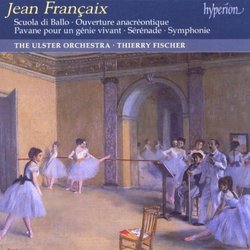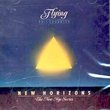| All Artists: Jean Francaix, Thierry Fischer, Ulster Orchestra Title: Francaix: Scuola Di Ballo / Symphony in G, etc. Members Wishing: 3 Total Copies: 0 Label: Hyperion UK Original Release Date: 1/1/2002 Re-Release Date: 5/14/2002 Album Type: Import Genre: Classical Style: Symphonies Number of Discs: 1 SwapaCD Credits: 1 UPC: 034571173238 |
Search - Jean Francaix, Thierry Fischer, Ulster Orchestra :: Francaix: Scuola Di Ballo / Symphony in G, etc.
 | Jean Francaix, Thierry Fischer, Ulster Orchestra Francaix: Scuola Di Ballo / Symphony in G, etc. Genre: Classical |
Larger Image |
CD DetailsSimilarly Requested CDs
|
CD ReviewsLike a Long Draft of Icy Spring Water on a Hot Summer Day J Scott Morrison | Middlebury VT, USA | 01/25/2004 (5 out of 5 stars) "Composer Ned Rorem has compared the French, whom he prefers, and who in his view are 'profoundly superficial,' with the Germans, whom he sees as 'superficially profound.' His description of the French applies with startling appositeness to the music of Jean Françaix. Françaix himself recasts Sacha Guitry's famous maxim, 'Ce qui n'est pas clair n'est pas français' ('That which is not clear is not French') as 'Ce n'est pas clair n'est pas de Françaix' ('That which is not clear is not by Françaix.') Influenced by Ravel and Les Six, Françaix (1912-1997) unfailingly wrote in a limpid style informed by more than a touch of the refined esthetic found so consistently in Ravel's music. Yet, like Ravel's, his music has a hidden sensuality that, when discovered, is seductive and addicting, at least to me. Most of Françaix's music has a light, often droll character. He was one of the first to use what has become, with many modern composers, neoclassic eclecticism; he borrows liberally from styles of the past. His 'Sérénade', written in 1934 and included here, anticipates the similar style Stravinsky used in his 'Dumbarton Oaks Concerto' and 'Jeu de cartes.' Entirely winning, this little 9-minute suite uses the varying meters and tongue-in-cheek sassiness made so familiar by Stravinsky. The Symphony in G Major, the third of Françaix's symphonies (none of them is numbered, however) is most easily described as a marriage of Haydn and Stravinsky (Harold Shapero's 'Symphony for Classical Orchestra' comes to mind). I is jaunty, II pensive, III has wheeze-box alternating chords reminiscent of those in 'Petrouchka' and includes a three-legged tango. IV, a saucy Allegro, is the most Haydnesque but goes delightfully far afield harmonically. 'Ouverture anacréontique' is an 11-minute ode to wine, women and song. (Anakreon was the Greek poet who wrote poems on those most convivial of subjects.) Lushly scored string-based love songs alternate with lively wind-dominated passages suggesting dancing and drinking. 'Scuolo di Ballo' is the earliest work here, written for a ballet based on a tale by Goldoni and using many quotations from the string quintets of Luigi Boccherini, the 18th-c. Italian cellist and composer who virtually invented the two-cello quintet. The longest work here at 25-minutes, this is quintessential neoclassic ballet music that limns a tale of rivalry amongst members of a ballet company. One of them is a klutz, and the music amusingly depicts her clumsiness, as well as the swooning pas de deux of the prima ballerina and her partner. The most moving piece here--probably 'moving' is not a word often associated with the usually insouciant Françaix--is the 4-minute, pointedly-titled 'Pavane pour un Génie vivant' ('Pavane for a Living Genius') written in 1987 and dedicated to Ravel on the fiftieth anniversary of his death. Modeled closely on Ravel's famous and well-loved 'Pavane pour une infante défunte' ('Pavane for a Dead Princess') and using an oboe theme, much slowed down, that is the opening motif of Ravel's 'Tombeau de Couperin,' -- Ravel's own work of homage -- this lovely work manages to tug at the heartstrings while causing one to marvel at the craft and skill involved in this deeply felt tribute to two of Françaix's musical predecessors. Thierry Fischer, the accomplished Swiss-French conductor of the Ulster Orchestra, conducts with much finesse and nuance, and his orchestra--surely becoming one of the 'majors' of the recording industry--repay him with adroit and silken playing. Strongly recommended. And with a recommendation that you seek out other recordings of Françaix's music whose music, sometimes disparaged as 'slight,' never fails to please. I'm particularly fond of an issue on Wergo entitle 'Musique pour faire plaisir' ('Music to give you pleasure') and another with the harpsichord concerto. He also wrote a wonderful, much more serious oratorio called 'L'Apocalyse selon Saint-Jean' ('The Apocalypse According to Saint John'). TT=70:25 Scott Morrison" Charming and Witty Music D. A Wend | Buffalo Grove, IL USA | 10/01/2002 (5 out of 5 stars) "I am familiar with the music of Jean Francaix (1912 - 1997), so this disc was one that I had on my list to buy at once. The works are from various parts of his career. Of the works played here, I was familiar with the Serenade (from 1934), which I heard many years ago on an old LP. I was pleased to see it included here. Francaix's music reminds me in a aural sense of the painting of Henri Matisse: they are like a good armchair to a tired businessman. His music is light and charming but also well written, filled with delicate rhythms and subtle shadings. The symphony played here is actually Francaix's third and last (written in memory of Joseph Haydn in 1953); he did not number his symphonies. The symphony has a classical format in the four short movements but the music does not, like Prokofiev's Classical Symphony, attempt to recreate an 18th century sound. The Scuola di Ballet is based on the music of Boccherini and was choreographed by Leonide Massine. It has been a highly successful work and was first recorded in the 1930s. The work is neo-classical, much like Stravinsky's Pulcinella.The Overture anacreontique is from 1978 and in this composition M. Francaix imagines a world without war. The Pavane pour un genie vivant dates from 1987 and is homage to Ravel to mark the 50th anniversary of his death. It is scored for a small orchestra and is evocative of Ravel's music. The music is beautifully played and recorded. I have always found Francaix's music to be a delight. His music was popular in German where it was taken to represent the French character. Perhaps this best describes his works: charming, witty and sometimes profound." Subtlety and Wit: Music of Jean Francaix M. C. Passarella | Lawrenceville, GA | 02/02/2008 (5 out of 5 stars) "Some music makes its points so quietly and subtly that your first and maybe even third impression of it is "so what?" A case in point: the Symphony of Jean Francaix. Early mental notes that I made about it run something like "Reminds me of a melodically challenged Ravel." "If this is a tribute to Haydn, Haydn should be insulted." And indeed, as a symphony paying homage to Classical style and content, it initially seems lacking compared to that most famous of classical symphonies, No. 1 by Prokofiev. But give the Symphony time, and its special qualities emerge, not least the amazing bursts of Dionysiac energy lurking beneath the serene Apollonian surface of the first and last movements. At points, these movements erupt, bass drum and percussion briefly pounding away, and then subside into their predominantly quiet, divertimento-like demeanor. It is as if the composer suddenly wants to remind us that this is, after all, the raw, noisy, complicated 20th century, and welcome back to it.
As to the melodies or lack thereof--true, Francaix is not primarily a melodist. You will search these works in vain for the gracious airs that, say, Poulenc lavishes on his best-known work. But then Francaix is paying tribute to the Classical era and its reliance on short motives that can act as building blocks rather than ear-catchers. So, all things considered, this interesting Symphony is a worthy tribute to Haydn. The attractive Serenade is closer in spirit to the cheekiness and irreverence of a Poulenc, Milhaud, or Ibert, at least in his Divertissement. It is sheer fun to listen too and yet with a dreamy, languid second movement that is highly distinctive, more than just fun. I find the bland Ancreontic Overture the low point of the disc--you may have a different impression--while the high point for me, despite my appreciation of the Symphony, is "Scuola de Ballo." Here, Francaix arranges the music of Boccherini, and it is the combination of Boccherini's charming melodies and Francaix' witty, imaginative instrumentation that makes this a hit for me. In fact, if Boccherini's melodies were just a bit more memorable, this piece would be as well known Walton's "The Wise Virgins" or Respighi's "Boutique Fantasque." Then again, Francaix' music is on a higher plane, more in line with what Stravinsky achieved in "Pulcinella," which pretty much started the whole back-to-Bach movement. And I guess Francaix deserves credit for not pandering: he could, after all, have appropriated the famous Minuet or Fandango of Boccherini. Fischer and his band do a superb job of capturing the subtle moods and distinctive colors of this music, and Hyperion provides a big and very handsome sound picture. So, Vive Francaix! " |





